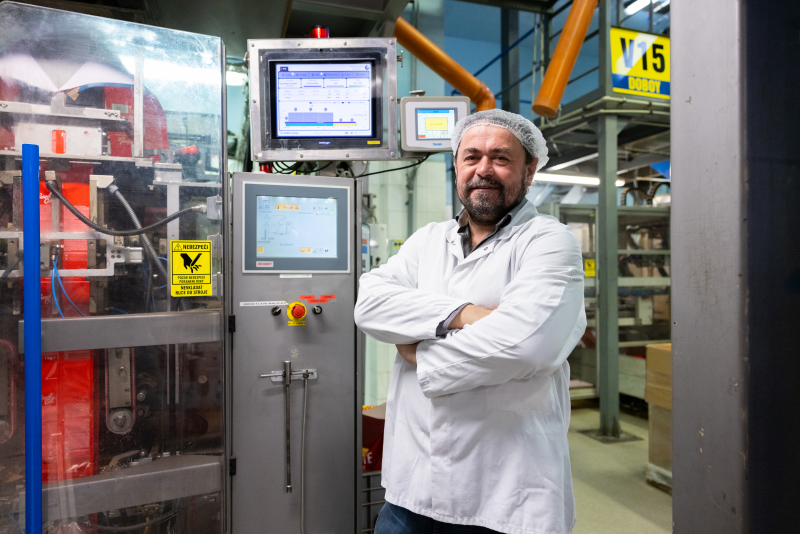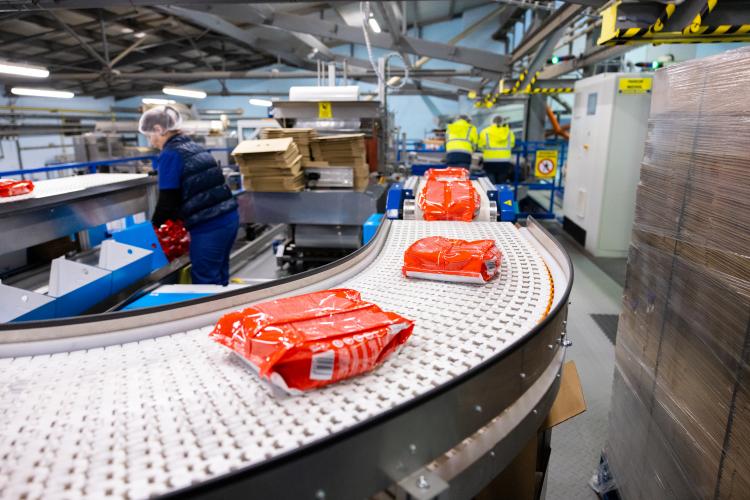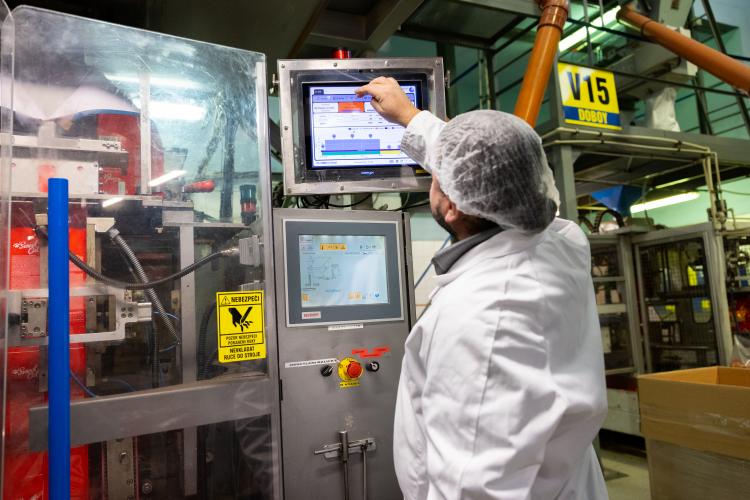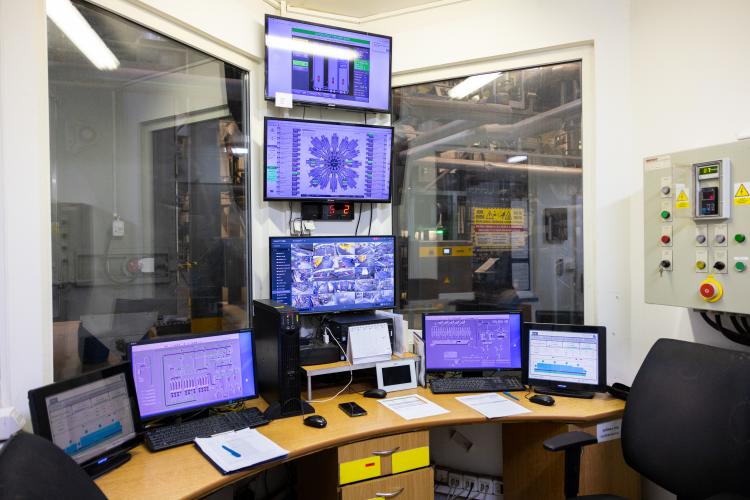Partner in Pet Food
From Paper to Digital: How a Leading Pet Food Manufacturer Found Success

Many leading manufacturers across industries have already optimized their production with MES SoftLi. One of them is Partner in Pet Food – a leading pet food manufacturer operating in 10 European countries. Known for a culture of efficiency and solution-oriented thinking, PPF found a perfect match in SoftLi. No wonder the collaboration has been seamless. We asked Zdeněk Zahejský, Production Manager at PPF, to share their experience.
When did you start thinking about digitising production?
Probably right after I joined PPF 6 years ago, when all production records were still kept on paper. And in some areas, they weren't even maintained at all. This was a big difference from my previous job, where we used monitoring systems for production on injection moulding machines.
Can you compare the situation back then with today?
Today, we’re miles ahead – not just compared to where we were, but compared to most manufacturers out there.
How was the digitalisation of your production?
We started by implementing the SoftLi MES system. It’s a data collection platform that allows us to analyze and evaluate production data, and generate reports – both for our internal needs and for the company’s management and owners.
What started as a trial quickly turned into a success. MES proved to be a perfect fit, earning the approval of both the team and management. Over time, we integrated additional modules, evolving the system into one of the most advanced setups within the PPF Group. Colleagues from other plants often visit us for inspiration and insights into how we’ve transformed our production with a cutting-edge MES.
What do your colleagues from abroad find the most interesting?
What interests our colleagues from abroad most often depends on their role – a production manager is drawn to different modules than, say, a quality manager. But what impresses everyone, including top management, is when I show them that I’m always online, able to see the operator’s screen in real time and able to show them the latest reports at any given time.
Your company is committed to maximum flexibility in every aspect of your business. Have you customised your MES accordingly?
Yes, in cooperation with SoftLi, we’ve customised parts of the system to ensure the MES meets our specific needs. It’s now fully integrated with our ERP, and both systems work in perfect harmony, automatically exchanging all necessary data.
Can you give an example of how the MES and ERP systems exchange data?
Sure. For example, MES pushes data straight into ERP, and pulls data like the bill of materials (BOM) back in. There’s a lot happening in the background – the system is highly robust and fine-tuned down to the last detail. And that’s exactly what gives us a real edge over others.
You’ve also implemented a planning system, right?
Yes. We saved that for very last. In hindsight, I can probably admit it now – I was genuinely worried it wouldn’t work out.
Why?
Well, at my previous company we tried to implement a planning system twice – and both times we gave up. It was just too complex and confusing for the planners and production staff. In the end, they always went back to Excel because it was easier to use.
What was different at PPF?
On the surface, the setup was similar – production was planned in ERP and Excel, with no visual overview like a Gantt chart. The real game-changer was the choice of MES supplier and their approach to implementation.
From day one, we had a clear mutual understanding with SoftLi regarding the goals and scope of the implementation. We clearly defined what we wanted from the system, and they tailored it to our needs. Of course, the process evolved over time and it took a while to fine-tune everything, but today it works perfectly. For me, it’s the first production planning solution that not only works in practice, but is also embraced by the people who use it every day.
As a manager, it’s important for me to ensure that any new tool is seen as a genuine aid – not an added burden. If employees don’t see the value, they’ll naturally find ways around it, and the whole effort falls flat.
What I really appreciate is that MES SoftLi has become a natural part of our daily operations. Every morning, we review life data from the previous day during team meetings and use it for instant analysis. Our planners love the planning module – it saves them time and simplifies their work. Even other departments benefit by easily checking when jobs are scheduled to run.
As a manager, it's great to see that MES is actively used and valued across the company. It’s not just a tool – it’s become an indispensable part of how we work.
So you don't use Excel anymore?
We now only use Excel for certain outputs. That’s mainly because our operators were used to receiving the production schedule in Excel for many years, so I haven’t changed that part just yet. I chose a softer, step-by-step approach to implementation, gradually convincing people of the need to move forward.
Each new implementation gets easier, as employees begin to understand the purpose behind it – and that the changes are here to make their work easier. It just needs a bit more time to naturally reach every last operator before we switch to full digitalisation.
Do you also cooperate with SoftLi during this transitional phase?
We’ve introduced a helpful transitional solution – the planner now generates the Excel sheet automatically, so the planner doesn’t have to do it manually. Eventually, we’ll stop using Excel completely. Operators will then be able to see what’s running directly in the planner via the web interface.
Were there any issues during the implementation of MES SoftLi?
There is one problem, but it's not MES's fault. PPF has a presentation standard that each branch must follow. We don't follow it because we no longer write with markers on whiteboards or paper. We try to get everything onto screens instead. We use televisions and life data everywhere. And we're penalized for that.
In corporations, it sometimes takes time for top managers to get used to such innovations. That's why they often stubbornly stick to the 'old good' methods from the past century, even though you're doing exactly what Japanese lean production specialists or pioneers of Industry 4.0 were calling for back then, even though it wasn't technologically possible at the time.
But this goes even further. We're far beyond the standard. But in the evaluation table, there's no box for it. On a scale of 1 to 5, we should get a 6, but that column doesn't exist. So, we get a reduced rating because we don’t follow the corporate standard.
What were you most concerned about when you decided to implement MES?
At the time I joined PPF, I was just getting to know the company and wasn't aware of the possibilities available. Trying to introduce something new right after joining a new company always comes with some uncertainties. And, of course, you need to convince your supervisors that it makes sense to implement the solution.
There are also concerns from the implementers' side. If the company is still operating with Excel and hasn't established anything else, it becomes challenging to say: "I need this much for this, or this much for that. Or this much for this." It depends on how far we want to go with the implementation.
When I arrived at PPF, the MES system was uncharted territory. I didn’t know how far we could go or whether my efforts would result in an actual implementation. That was a real concern for me, as the company also needed other things – investments in machines, regular maintenance, etc.
So what made the decision-makers approve your idea in the end?
My boss is a forward-looking leader who embraces Innovation. When I showed him the principles of MES SoftLi and explained everything, he got interested right away. He read more about it, reached out to industry peers, and soon gave us the green light for the first implementation.
How did it go?
At first, we ran MES as a trial. It didn’t cost much, but it gave us just enough to prove its value to our superiors. Once the benefits became clear, we started expanding into other key production processes.
Each year we added at least one new module – sometimes even two. In some cases, we added modules outside the planned budget, just because they helped solve an urgent problem. Management gave us the green light for extra investment, simply because they saw how powerful MES really is.
Today, the whole company is well connected, so we can fully enjoy the benefits the system offers – and continue investing into new projects.
You said the first quick benefits of the trial convinced management. What were they, exactly?
One major advantage for me personally was being able to see life data collected from production, which allowed me to immediately analyse the issues on the spot.
I had come to PPF from a different type of manufacturing and a different environment, so I first needed to understand in detail how things worked here. For example, during morning meetings we discussed the previous day's events – and I often felt a bit lost.
Then I saw the life data and realised there were lots of short downtimes on the production line that weren’t being recorded anywhere. A machine would run for two minutes, stop for one, run again for three, and then pause for another 30 seconds.
Over a 24-hour period, this added up to a significant amount of downtime – yet the operators hadn’t recorded any of it in their handwritten logs. It was only thanks to the life data that I could say: “There’s a problem here, and we need to focus on this and that.”
With these kinds of insights in hand, I could turn to my managers and say, “Look, this is the machine that breaks down the most. Let’s do something about it – invest and get it fixed.”
Thanks to real life data, we could finally see what was broken, what wasn’t working right, or what was close to wearing out – and fix or replace it in time. We know exactly what problems are coming and how to deal with them. That’s why our performance and efficiency just keep getting better.
Can you share the impact MES had in terms of savings, productivity gains and reduced downtime?
In our type of production, it's quite difficult to quantify this precisely. We’re highly customer-oriented, which means our product portfolio constantly changes based on customer demand. Every quarter, we update up to 20% of the portfolio. And each new product brings slightly different and specific challenges.
That's why it's not possible to clearly say, for example, that our performance in OEE has improved by 10% – because the introduction of new products always brings new difficulties, which inevitably distorts the OEE metric.
That said, I can confirm that over the past five to six years, we’ve increased productivity by roughly 20%.
You mentioned that you already had experience with MES implementation in your previous job. How would you compare these two processes?
In my previous role, I implemented an MES solution with a large multinational corporation. At PPF, we opted for a smaller supplier – and I’ve found the collaboration significantly smoother. Larger companies often struggle to adjust their internal processes or make the necessary customizations to suit the customer’s needs.
SoftLi, on the other hand, is much more flexible. We’re still working within a standard, but they’re always willing to tailor things to what we need. That’s a huge plus, especially compared to the issues our sister companies have with bigger suppliers.
And their support? Top notch. I just call, and I get help straight away.
What module are you planning to implement next?
I’d go for the quality module – product documentation, checklists and forms. I’m excited about the idea that with detailed tracking of temperatures, humidity and other data, we can push our efficiency even further.
Thank you for the interview.
Do you also want to optimise your production?
We help manufacturers of all sizes increase efficiency by up to 20%.
No paper. No downtime. No excuses.
We are the only ones offering a free and instantly available DEMO, as well as the option to test the system on your own machines, without any commitment.


